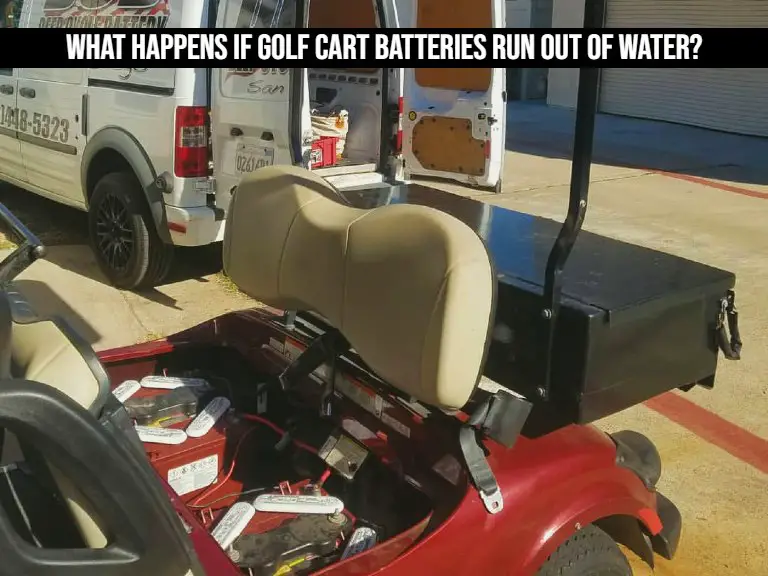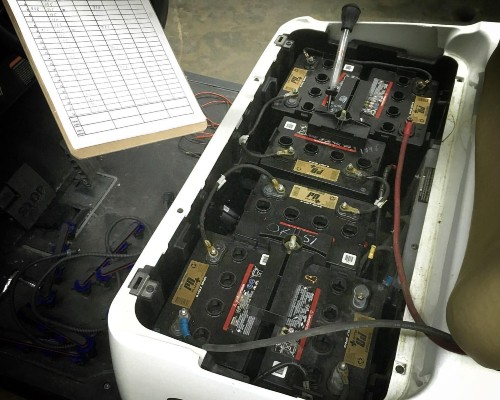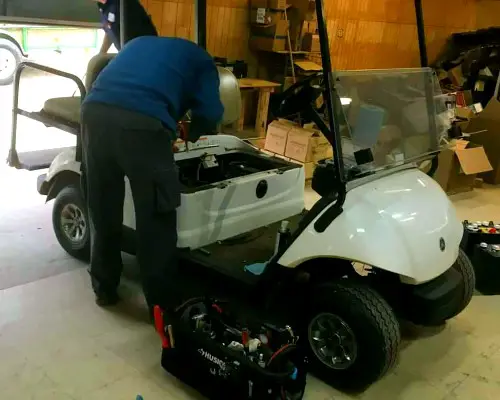
It’s a commonplace mishap when golf cart batteries lose their water, a vital but regularly neglected element of maintenance.
Neglecting the water levels on your golfing cart batteries can result in a cascade of problems, from diminished overall performance to potentially pricey repairs.
Understanding the consequences and preventive measures can prevent this surprising pitfall.
Let’s discover the unseen dangers lurking in the battery cells and how simple vigilance can keep your golfing periods uninterrupted.
The Importance of Water in Golf Cart Batteries
Golf cart batteries, especially those that might be lead-acid kind, depend intently on the water for perfect performance and toughness.
1. Electrolyte Composition
Water is important for maintaining the electrolyte stability vital for electricity generation in lead-acid batteries.
2. Heat Management
Adequate water levels in the battery help in effectively managing the heat generated during its operation.
3. Preventing Sulfation
Maintaining proper water levels helps reduce sulfation, which can hinder battery performance.
4. Maintaining Battery Capacity
Proper water levels are crucial for preserving the battery’s ability to hold a charge and prolonging its usage time.
5. Avoiding Internal Damage
Low water levels can lead to oxidation and corrosion of the internal lead plates, damaging the battery.
Consequences of Water Depletion in Golf Cart Batteries

Impact on Battery Life and Performance
When golf cart batteries run low on water, It’s a serious issue that can significantly impact their life and performance. Here’s the lowdown:
1. Reduced Capacity and Efficiency
When the battery’s ability to hold a charge diminishes, it works harder to deliver the same power, draining its energy faster.
2. Increased Internal Resistance
In this the battery struggles more to conduct electricity, reducing its overall efficiency and responsiveness.
3. Accelerated Aging
Dry batteries age like bananas in the sun – faster than you’d like. The plates inside the battery can become permanently damaged, leading to a shorter lifespan.
Safety Risks Associated with Dry Golf Cart Batteries
1. Overheating and Fire Risk
Dry batteries can get hotter than a summer season barbeque. This excessive heat can cause melting, fires, or maybe explosions.
2. Release of Harmful Gases
When water stages dip too low, batteries can emit risky gases. It’s not just smelly; it is a health hazard, like invisible toxic fumes lurking around.
3. Electrical System Damage
A dry battery will have a disastrous effect on your cart’s electrical system. It’s like a domino effect, one problem leads to another, and before you know it, you’re coping with a whole host of electrical gremlins.
Best Practices for Checking and Refilling Water Levels in Golf Cart Batteries

1. Safety First
Always wear protective gear like gloves and goggles.
2. Inspect the Battery
Check for any visible damage. If the battery is cracked or leaking, it’s unsafe to proceed.
3. Check Electrolyte Levels
Open the battery caps. If the plates are exposed, the battery is water-depleted.
4. Refill with Distilled Water
Slowly add distilled water to each cell until the plates are just covered. The water should cover the battery plates by about 1/2 inch.
Avoid overfilling. If distilled water isn’t available, use deionized water as an alternative. Avoid the usage of tap water as it may introduce impurities.
5. Charge the Battery
Use a proper charger and set it to the lowest rate. Charging should be done in a well-ventilated area.
6. Recheck Water Levels
After charging, recheck and adjust the water levels if necessary.
7. Battery Testing
Test the battery with a voltmeter or hydrometer. A fully charged cell should read around 2.1 volts
Note: Check the water levels in your golf cart batteries at least once a month. Consistent monitoring helps in maintaining optimal performance and prolonging battery life.
Final Thoughts!
We’ve delved into the technical components of water’s role in golf cart batteries, an often-unnoticed component is the environmental impact.
In areas with excessive temperatures, the rate of water loss can be extensively higher, leading to greater frequent maintenance needs.
It’s critical to recognize that preserving water levels on your golf cart batteries is not just about preserving the battery’s life, but also about making sure efficient and safe operation in various environmental conditions.
So, everyday checks and maintenance of water levels in golf cart batteries are critical for optimum performance, safety, and sturdiness.
FAQs
Can dry golf cart batteries be recharged?
No, dry golfing cart batteries can’t be recharged. If a golf cart battery has completely dried out, it means the electrolyte level is too low, which causes irreversible harm to the battery plates. So, the battery will need to be replaced.

Bob is a golf equipment expert with a wealth of knowledge about the latest and greatest golfing gear. Bob is our Lead Product Reviewer and provides in-depth reviews and recommendations on the best equipment for golfers of all levels. He takes a hands-on approach to testing, using his extensive experience on the course to provide the most accurate and reliable product recommendations. Join Our Team!
